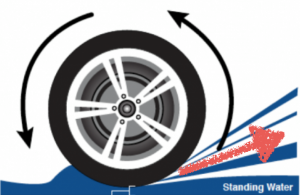Have you ever gotten splashed by a car while walking on the streets? Have you ever been driving on a rainy day and were unable to see properly through the windscreen? In fact both of the situations are related to the water spray of car wheels.
https://www.youtube.com/watch?v=bJCghZIFVrg
The video above is about people splashed by cars which is quite common during a rainy day.
The spray and splash of wheels can cause serious consequences such as car accidents. As there will be a myriad of puddles during a rainy day, it reduces the visibility of road users every time when a wheel hits a puddle and causes the splash and spray. Therefore drivers average a longer reaction time to avoid any potential collisions with other cars. According to previous studies, car accidents are 70% more likely to happen on rainy days than during dry conditions. In addition, rainfall and wet pavement can cause approximately 12,000,000 accidents per year. The following picture is an example of a reduced visibility during a rainy day.

Title: Scene of a rainy day by a driver’s perspective
Source: https://www.shutterstock.com/video/clip-20356243-stock-footage-pov-close-up-cars-speeding-on-dangerous-multilane-highway-with-poor-visibility-on-dark-foggy-and.html
Researchers from the University of Southern California explored the mechanisms behind water spray using fluid mechanics (the response of fluids to the forces exerted on them); however, the basic mechanism behind this can be explained by the contact between the puddle and the car wheel. When a car is driven pass a puddle in a high speed, a huge amount of water drops attaches to the wheel and have the same angular acceleration (the acceleration of an object moving in circular motion) as the wheel. As the car continues to travel in a high speed, the water drops will gain enough inertia and leave the tire.

Sketch of water leaving a rolling car wheel Source: http://www.wp-industrial.co.uk/Elastohydrodynamic_Lubrication.html
Above is a sketch of water leaving a rolling wheel. Since the water is travelling with an angular acceleration, it will leave the wheel with a velocity and continue on the path represented by the big red arrow.
In order to increase driver’s visibility on rainy days, researchers have come up with the idea of Curtair to reduce the volume of water sprays. Curtair is an air curtain that surrounds a car wheel with air nozzles and a moisture sensor. When the car is driven under wet conditions, the sensor will be able to detect water and make the air nozzles release air. Thus, a smaller volume of water spray will be produced.

Photo of a new technology (Curtair)
Source: https://projects.ncsu.edu/project/nsaudiovideo/pdf/curtair-poster.pdf
There are no further discussions regarding the results of Curtair, but we can reasonably predict that the invention may positively impact the visibility of drivers.
– Conway Chen
